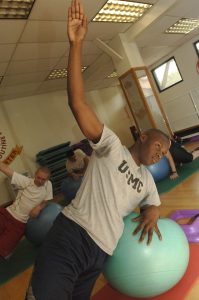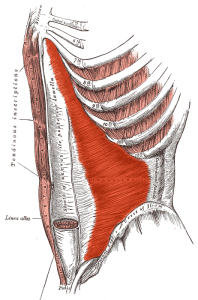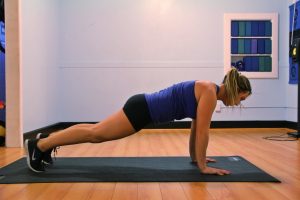1 Core muscles and exercises
Background
What muscles and exercises come to mind when you hear or read the word “core”? Many people think these are the muscles of the abdominal wall and maybe the back, but as a student of exercise physiology you may recall your coursework defining core as more muscles. Specifically, the core encompasses muscles of the abdominal wall and “deep abdomen”, back, spine, and pelvis. If the muscle moves or stabilizes the back, it is part of the core.
The core muscles are essential to many dynamic exercises and sports, as well as movements of daily living. Even the seemingly simple movement of bending over to tie your shoes uses core muscles! Further, worldwide low back pain is the leading cause of disability. Together, this makes exercises that strengthen the core and reduce the risk of injury crucial for most people.
Who should do core exercises?
Just about everyone should do core exercises. 
How young can someone start doing core exercises?
Resistance training is generally thought to be safe in children mature enough to follow directions for strength training, usually somewhere between 8-10 years. However children younger than this may benefit from safe, simple exercises that engage the core such as leg lifts, bridges, and crab walks.
Who needs modifications?
There are many groups that have a high likelihood of needing modified core exercises. Some groups are probably obvious, like those with a recent back surgery. Pregnancy and post-partum are two well-known periods of time where core exercises will need to be modified. Other people that will likely need modifications are people with ostomies or who have had recent surgeries of the front of the body, such as open-heart surgery. When in doubt, talk to the person about their exercise restrictions/exercise cautions and have them speak to their physician or physical therapist.
Transverse abdominis: Nature’s corset
 The transverse abdominis is often called nature’s coreset, because of the way it can draw in the waist and stabilize the core. This is a really important core muscle to keep strong, as it helps stabilize the core throughout weight lifting movements. You can do transverse abdominis exercises laying down with knees bent or is a seated position with good posture. Exhale, and as you inhale draw your navel in toward your spine. Hold that contraction (breath normally!), then relax and repeat. For those of you that like video demonstrations, here is one: Video example of TA contraction activity
The transverse abdominis is often called nature’s coreset, because of the way it can draw in the waist and stabilize the core. This is a really important core muscle to keep strong, as it helps stabilize the core throughout weight lifting movements. You can do transverse abdominis exercises laying down with knees bent or is a seated position with good posture. Exhale, and as you inhale draw your navel in toward your spine. Hold that contraction (breath normally!), then relax and repeat. For those of you that like video demonstrations, here is one: Video example of TA contraction activity
Drawing of transverse abdominis from Grey’s Anatomy (the 1918 book, not the TV show)
What is the FITT for core exercises?
The specific details of the FITT will vary by person and their fitness goals. Core exercises can be done 3-7 days/week, depending on intensity and goals of the exercises. The intensity will also vary, but core exercises are generally not performed at a high or vigorous intensity. Time for core is typically 5-20 minutes per session. There are many types of core exercises, and like other types of resistance exercise the muscle groups can be rotated and exercises done daily, or several muscle groups can be done during one session with rest days in between. For example, in a split routine M/W/F can be exercises that are abdominal wall and anterior pelvis dominant, and T/Th/F exercises for the back/spine.
When to do core exercises in an exercise session?
In general physical fitness programming, core exercises are the last set of exercises before the end-of-session stretching exercises. By doing the core exercises last, the core muscles will not be as fatigued during the main exercises, which may reduce the risk for injury. When doing the core exercises at the end, it is “ok” for the core muscles to fatigue because they are no longer being used to keep the body upright while running, or stabilizing the back in a squat.
Recent trends in exercise include more interval training classes, such as boot camp and boot camp style classes. This also includes popular franchises such as OrangeTheory Fitness, F45, and Camp Gladiator, among others. In this style of class, participants move among exercises or stations and in this format the core exercises are often dispersed through the workout. This allows the person to have less rest time, and instead the ‘rest’ is to use a different group of muscles. This format is acceptable for most healthy adults, as long as they remember (or are cued to remember) to keep their form for all exercises so that they do not increase their risk of injury.
Types of core exercises
There are many core exercises, which can be combined throughout the week so that most, if not all, of the core muscles receive exercises. The specific exercises should be specific to the individual; take into account the experience and injury history of the participant. Some popular core exercises include back extensions, dead bug, plank, and bicycles. There are also exercises such as burpees, which work several core muscle areas.
Activity
-
Use your own experiences and the internet to search for a set of exercises to train a wide range of core muscles. Come up with a one week core exercise for a generally healthy adult with moderate fitness.
Media Attributions
- USMC-18994 is licensed under a Public Domain license
- Transversus abdominis is licensed under a Public Domain license
- Plank © Jaykayfit is licensed under a CC BY-SA (Attribution ShareAlike) license

